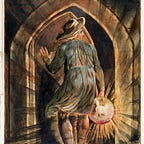Cave Art is not about the Art, it’s about the Artist!
“The power that man has over nature and himself, and that a dog lacks, lies in his command of his imaginary experience. The symbol is the tool which gives man his power, and it is the same tool whether the symbols are images of words, mathematical signs or mesons.” Jacob Bronowski
While anthropologists debate the relationship between Homo sapiens (on the left ) and Homo neanderthalensis ( on the right) there’s little doubt that both Species of Homo possessed the ability “to imagine” and use symbols to represent things and events both in the past and most likely in the future as well.
A 2018 study claimed an age of 64,000 years for the oldest examples of cave art in Iberia, which implies it was created by Neanderthals rather than modern humans (Sapiens).
According to famed biologist E.O. Wilson “We are a a biological species arising from Earth’s biosphere and one adapted species among many; …however rich and subtle our minds, however vast our creative powers, the mental process is the product of a brain shaped by the hammer of natural selection upon the anvil of nature…Otherwise we would not use the term humanities to denote the study of those very special phenomena that make us human.”
While Dr. Wilson is very poetic when he writes
“however vast our creative powers, the mental process is the product of a brain shaped by the hammer of natural selection upon the anvil of nature”…
his comments might lead a reader to think “the mental processes” of homo sapiens are no different than those of other creatures “shaped by the hammer of natural selection upon the anvil of nature” but they are different!. The brain/mind of Homo Sapiens, while it has indeed evolved over a quarter of a million years or more, has done so quite differently from a brain of other creatures that also developed through an evolutionary process.
I began this essay quoting Jacob Bronowski on man’s use of “The symbol” and how man can use symbols to describe events in the future as well as the past. According to Dr. Martin Seligman and his colleagues at the University of Pennsylvania;
“Our species is misnamed. Though sapiens defines human beings as “wise”, what humans ended-up being able to do especially well after our evolutionary journey is ‘prospect’ the future.”
Dr. Seligman refers to us not as Homo Sapiens but rather as Homo Prospectus. According to him it is our abilities to “anticipate and evaluate” future possibilities for guidance of thought and action that is the cornerstone of human success.”
Fictional languages, like the following example of the “Evlish” language, created by J.R.R. Tolkien for his Hobbit, are “constructed languages” created as part of a fictional setting, for example in books, movies and video games.
Fictional languages are intended to be the languages of a fictional world and are often designed with the intent of giving more depth and an appearance of plausibility to the fictional worlds with which they are associated, and to have their characters communicate in a fashion which is both alien and dislocated. However, fictional languages are not that much different than the language of scientists struggling to explain phenomenon in the physical world. The only real difference is that scientists work to verify their fictional languages while other story tellers skip the verification, preferring the mystery that surrounds their stories.
J.R.R. Tolkien’s The Hobbit uses fictional language to describe a time “between the Dawn of Færie and the Dominion of Men”. It follows the quest of home-loving hobbit Bilbo Baggins to win a share of the treasure guarded by Smaug the dragon. Bilbo’s journey takes him from light-hearted, rural surroundings into more sinister territory. This is one of Tolkien’s original illustrations of his protagonist in the Hobbit, Bilbo Baggins.
Historian Yuval Harari says, “The real difference between us and chimpanzees is the mysterious glue that enables millions of humans to cooperate effectively. This mysterious glue is made of stories, not genes.”
According to Dr. Harari, we cooperate effectively with strangers because we believe in things like gods, nations, money and human rights. Yet none of these things exists outside the stories that people invent and tell one another.
There are no gods in the universe, no nations, no money and no human rights — except in the common imagination of human beings. They are the same kinds of stories that Homo Neanderthalensis sat around telling each other about how they fought and would fight their hunting prey. Cave art was simply the visual representation of those stories. The same visual representation used by modern human beings today.
